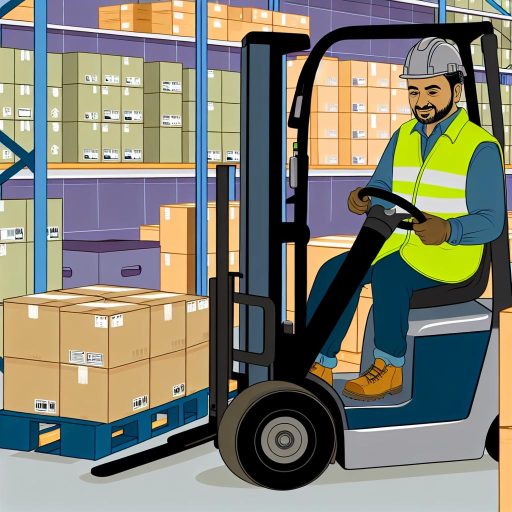Introduction:
Aspiring lumberjacks must prioritize health and safety to prevent accidents and injuries in their profession.
It is crucial to follow specific guidelines to ensure a safe working environment.
Wear the Proper Safety Gear:
Always wear a hard hat, safety goggles, ear protection, gloves, and steel-toed boots while working.
Proper Training and Technique:
Receive proper training on how to operate equipment, use tools correctly, and practice safe cutting techniques.
Stay Alert and Focused:
Avoid distractions and be aware of your surroundings at all times to prevent accidents.
Regular Breaks and Hydration:
Take frequent breaks to prevent fatigue and stay hydrated to maintain peak performance.
Inspect Equipment Regularly:
Regularly check equipment for any damage or issues that may compromise safety.
Repair or replace as needed.
Weather Conditions:
Be mindful of weather conditions such as strong winds, rain, or snow that may impact working conditions.
Emergency Preparedness:
Have a first aid kit on hand, know emergency procedures, and have a plan in case of accidents.
Communicate with Team Members:
Effective communication with team members is essential to ensure everyone is working safely and efficiently.
Listen to Your Body:
If you feel tired or unwell, take a break and rest to prevent injuries due to fatigue.
Understanding the Risks:
Lumberjacks face common risks such as falling trees, equipment malfunctions, and adverse weather conditions.
It is crucial to be aware and vigilant to prevent accidents from happening.
Common Risks Faced by Lumberjacks:
- Falling Trees: One of the most significant dangers in the lumberjack profession is the risk of trees falling unpredictably.
- Equipment Malfunctions: Chainsaws and other machinery used by lumberjacks can malfunction, leading to serious injuries if not properly maintained.
- Adverse Weather Conditions: Extreme weather like strong winds, heavy rain, or snow can create hazardous working conditions.
Importance of Awareness and Vigilance:
- Being alert and conscious of your surroundings can help identify potential risks before they turn into accidents.
- Regularly inspecting and maintaining equipment can prevent malfunctions that could cause harm to the lumberjack.
- Following safety protocols and guidelines is essential to ensure a safe working environment for lumberjacks.
Preventative Measures:
- Attend training sessions to learn how to properly use equipment and recognize potential hazards.
- Wear appropriate protective gear, such as helmets, goggles, gloves, and steel-toed boots, at all times while working.
- Communicate effectively with fellow lumberjacks to coordinate activities and ensure everyone’s safety.
- Stay informed about weather forecasts to anticipate adverse conditions and plan accordingly.
- Take breaks when needed to avoid fatigue, which can lead to a lapse in concentration and increase the risk of accidents.
By understanding the risks, staying vigilant, and following safety procedures, aspiring lumberjacks can minimize the likelihood of accidents and injuries in their line of work.
Proper Training and Certification
Receiving proper training and certification is crucial in operating equipment like chainsaws and log splitters.
Attending safety courses will help aspiring lumberjacks learn the best practices in the field.
Proper training and certification are the foundation for a successful career as a lumberjack.
When working with heavy equipment like chainsaws and log splitters, it is essential to receive the proper training to ensure safety and efficiency in the workplace.
One of the key reasons why aspiring lumberjacks should consider obtaining proper training and certification is to prevent accidents and injuries.
Transform Your Career Today
Unlock a personalized career strategy that drives real results. Get tailored advice and a roadmap designed just for you.
Start NowChainsaws and log splitters are dangerous tools that require skill and knowledge to operate safely.
By undergoing training, individuals can learn how to handle these tools correctly and reduce the risk of accidents.
Moreover, receiving certification demonstrates a commitment to professionalism and excellence in the field of lumberjacking.
Employers are more likely to hire individuals who have undergone training and certification, as it indicates that they have the necessary skills and knowledge to perform their job effectively.
Another benefit of attending safety courses is the opportunity to learn best practices in the field.
Safety courses cover topics such as proper equipment maintenance, hazard identification, and emergency procedures.
By learning these best practices, aspiring lumberjacks can minimize risks and create a safe working environment for themselves and their colleagues.
In addition, proper training and certification can lead to career advancement opportunities for lumberjacks.
With the right training, individuals can expand their skill set and take on more challenging projects.
Certification can also open doors to higher-paying jobs and greater job security.
Proper training and certification are essential for aspiring lumberjacks looking to establish a successful career in the industry.
By investing in training and certification, individuals can acquire the skills and knowledge needed to work safely, efficiently, and professionally in this demanding field.
Find Out More: Landscape Architecture: Key Challenges and Solutions
Personal Protective Equipment (PPE)
As an aspiring lumberjack, it is crucial to prioritize your safety by wearing the necessary PPE.
Let’s delve into the essential protective gear that every lumberjack should have:
Helmet:
A helmet is vital to protect your head from falling debris and branches.
Make sure the helmet fits properly and securely to provide maximum protection.
Gloves:
Gloves are essential for protecting your hands from cuts, splinters, and blisters.
Opt for durable, non-slip gloves that provide a good grip on your equipment.
Eye Protection:
Safety goggles or glasses are a must to shield your eyes from flying wood chips and dust.
Transform Your Career Today
Unlock a personalized career strategy that drives real results. Get tailored advice and a roadmap designed just for you.
Start NowInvest in high-quality eye protection to prevent eye injuries on the job.
Steel-Toed Boots:
Steel-toed boots are crucial for keeping your feet safe from heavy objects and sharp tools.
Choose boots with good ankle support and slip-resistant soles for added safety.
Remember, wearing PPE is non-negotiable when working as a lumberjack.
PPE serves as a barrier between you and potential hazards, reducing the risk of injury.
Always inspect your PPE before each workday to ensure they are in good condition.
Replace any damaged or worn-out gear immediately to maintain optimal protection.
By wearing the right PPE, you are safeguarding yourself against potential workplace accidents.
Prioritize your safety by making PPE a non-negotiable part of your lumberjack gear.
Explore Further: Top Landscape Architecture Programs in the US
Safe Working Practices:
Maintain a safe distance from falling trees to avoid accidents.
Avoid working alone in remote areas to ensure help is available when needed.
Importance of Communication and Teamwork:
Effective communication is key to alerting others of potential dangers.
Teamwork helps distribute tasks and provide support in case of emergencies.
Working together creates a safer environment and reduces the risk of accidents.
By following these safe working practices and emphasizing communication and teamwork, aspiring lumberjacks can minimize risks and ensure a safe and productive work environment.
Remember, safety should always be the top priority in this challenging field.
See Related Content: Choosing the Right Paint for Your Home’s Interior
Proper Tool Maintenance
As an aspiring lumberjack, it is crucial to prioritize the maintenance of your tools and equipment.
Regular inspection and upkeep ensure they are in optimal working condition.
Transform Your Career Today
Unlock a personalized career strategy that drives real results. Get tailored advice and a roadmap designed just for you.
Start NowEnhancing efficiency and safety on the job.
Importance of Tool Maintenance
- Regular maintenance prolongs the lifespan of your tools, saving you money in the long run.
- Properly maintained tools perform better, resulting in improved productivity and quality of work.
- Well-maintained equipment reduces the risk of malfunctions and accidents while working in the forest.
Inspecting Tools
- Before each use, visually inspect all tools for any signs of damage or wear.
- Check for loose or missing parts that could affect the tool’s performance.
- Ensure handles are secure and blades are sharp to avoid potential hazards.
Sharpening Chainsaws
- Properly sharpened chainsaws are essential for cutting efficiency and safety.
- Use a file guide to maintain the correct angle while sharpening the chainsaw blade.
- Follow the manufacturer’s guidelines for sharpening frequency and technique.
Replacing Worn-out Parts
- Replace any worn-out or damaged parts immediately to prevent further damage or accidents.
- Keep a stock of spare parts on hand to quickly replace any components that become worn out.
- Follow the manufacturer’s recommendations for replacing parts to maintain the tool’s integrity.
By following these tips for proper tool maintenance, you can ensure that your equipment is always in top condition.
This allows you to work efficiently and safely as a lumberjack.
Learn More: Top Schools for Power Line Installer Training

Physical Fitness and Wellness
Being a lumberjack requires a high level of physical fitness due to the demanding nature of the job.
Lumberjacks need strength, stamina, and endurance to handle the heavy equipment and perform tasks efficiently.
- Exercise Regularly: Engage in strength training exercises like weightlifting and cardio to build endurance.
- Eat a Balanced Diet: Consume a variety of fruits, vegetables, lean proteins, and whole grains for optimal nutrition.
- Stay Hydrated: Drink plenty of water throughout the day to prevent dehydration, especially in hot weather.
- Get Enough Rest: Aim for 7-9 hours of quality sleep each night to allow your body to recover and rejuvenate.
- Stretch and Warm Up: Before starting work, stretch your muscles and warm up to prevent injuries and improve flexibility.
By prioritizing physical fitness and wellness, aspiring lumberjacks can ensure they have the strength and stamina needed to excel in their profession.
Mental health awareness is essential in every profession.
Being a lumberjack can be mentally challenging.
The physically demanding nature of the job adds stress.
Recognizing mental health challenges is crucial.
Taking steps to address them is important.
Managing Stress
- Practice mindfulness and relaxation techniques.
- Engage in regular physical activity to improve mood.
- Set realistic goals and prioritize tasks.
- Take breaks throughout the workday.
Managing Anxiety
- Stay organized and create a work schedule.
- Seek support from friends or a therapist.
- Avoid excessive caffeine and alcohol consumption.
- Practice positive self-talk.
Managing Other Mental Health Issues
- Connect with a therapist to discuss concerns.
- Stay connected with loved ones for support.
- Engage in hobbies outside of work.
- Consider joining a support group.
By prioritizing mental health awareness, lumberjacks can thrive.
Taking proactive steps can help maintain well-being.
Emergency Preparedness
Being prepared for emergencies is crucial for aspiring lumberjacks.
They work in remote areas where help may not be readily available.
Importance of Emergency Preparedness
- Emergencies can happen unexpectedly.
- Being prepared can save lives.
- As a lumberjack, injuries from falling trees are common risks.
- Equipment failures are also common risks.
- Inclement weather can pose dangers, such as storms or heavy snow.
Having a well-thought-out emergency plan can make a significant difference.
This preparation helps in handling critical situations effectively.
Tips for Creating an Emergency Plan
- Undergo first aid training to be equipped with necessary skills.
- Keep a first aid kit available at the worksite.
- Ensure all team members are aware of emergency procedures.
- Establish communication protocols for emergency services.
- Regularly review and update the emergency plan as needed.
Knowing how to contact emergency services is crucial.
For example, knowing the nearest hospital or fire department is vital.
Transform Your Career Today
Unlock a personalized career strategy that drives real results. Get tailored advice and a roadmap designed just for you.
Start NowPractice drills and simulations to familiarize everyone with the plan.
This ensures a swift response in real-life situations.
By prioritizing emergency preparedness, aspiring lumberjacks can work confidently.
They prepare to handle unforeseen challenges that may arise.
Prioritizing Health and Safety for Aspiring Lumberjacks
Health and safety should always be a top priority for aspiring lumberjacks.
By implementing the tips and practices mentioned in this blog post, you can ensure a safe and successful career in this field.
Always be mindful of your surroundings and take necessary precautions to prevent accidents and injuries.
Stay informed about safety protocols and continuously improve your skills to excel in this physically demanding profession.
Your health and well-being are paramount, so never compromise on safety measures.
By following these guidelines, you can build a successful career as a lumberjack while prioritizing your own health and safety.




